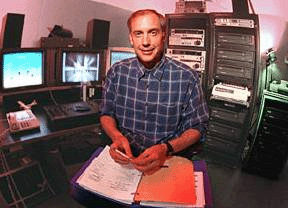But sound design is sonic sculpture, which means that it isn't all just about recording sound, or taking sound from a library. Sometimes the production, weather it be a film, game, radio production or whatever type of visual art may require the sound to be designed on a computer or on a synthesizer, or quite possibly the combination of the two if the sound designer is employing a software synth, which is quite possible given the emergence of programs such as Native Instrument's Reaktor over the last five years. With the ever-increasing processing power of computers, designers can now bask in the luxury of having all their favourite synthesizers, effects and plugins on a computer and not worry about their machines crashing. But back in the seventies it was a slightly different story. This is what legendary sound designer Ben Burtt of Star Wars fame had to say.
The digital revolution has made manipulating sound and sound mixes much easier than it was when Star Wars began twenty years ago. "Since we're working with computer files now," Burtt says, "it's technically easier to manipulate the sounds and move them around. Adding sound to a movie that's still being edited is just like applying paint to a house that's being constantly modified and rebuilt. If someone adds a balcony or removes a wall, you have to start over, and that's the way it was with sound back then. But with today's technology, the computer can keep track of everything, which makes such dynamic sound designing and editing less of a headache. Now we can build a very complex temporary mix, which is so much richer and deeper," says Burt. The translation from temporary sound tracks to final mix has also become less problematic.
"It used to be that when the final cut of a movie was decided up on, you would scrap the temporary sound mix and start building the final tracks. But now, you get to keep everything, because it's all digital and can be handled much more easily. So I'd say roughly 80% of the temp mix will end up in the final one." All of these technological advances don't necessarily mean that sound work is easier now than it was twenty years ago. "The creative process is just as big and just as hard," says Burtt, "but technology allows a smaller crew to tackle the challenge, and to do it in a more effective way. The sound crew on Episode I is about a third of what it was on Return of the Jedi, even though the task is just as complex." The extensive use of new technology allows for more freedom in the exploration and creation of sound, enabling the crew to concentrate more on art than on technical considerations." |


